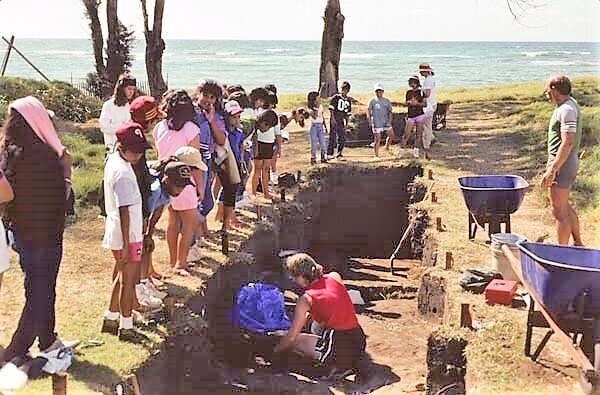Noho Ana I Ka Wā Kahiko Ma Waiheʻe: Life in the Early Days at Waiheʻe
The work done by Bishop Museum in the 1960s provided strong evidence of Waiheʻe’s place of importance to the people of Maui who had recently arrived — ‘mai kahiki mai’ — from foreign lands. In 1987 Dr. David Clark, a professor of archaeology from Catholic University of America in Washington D.C., asked for, and received, permission from the landowner, Wailuku Sugar Company, to conduct a field school at roundtable, not far from the site of Bishop Museum’s test pit M21 excavated 21 years earlier. Dr. Clark had several goals when he began this project. His first series of goals consisted of conducting a high quality archaeological study that would demonstrate the dimensions of the site, the history of occupation and to establish Waiheʻe’s significance in Hawaiian history. However, an equally important goal lay in conducting a community education program, that would involve any interested member of the community, with a special focus on elementary school children. In both instances Dr. Clark was incredibly successful.
Elementary school children watch archaeologist David Clark (right) and his team uncover ancient artifacts at the old Waiheʻe Dairy site in the 1980s.
Photo courtesy David Clark
Trenches were dug up to 8 to 10 feet deep as part of the excavation of the old Waiheʻe Dairy site.
Photo courtesy David Clark
While I will discuss the experiences of the community during Dr. Clark’s dig later, the amount of material, and the information and insights that this study revealed have both confirmed and expanded our understanding of life among this early Hawaiian community. During this project, Dr. Clark’s team dug through 2.5 meters of soil (~8 feet 2 inches) through six layers of sediment before they hit soil that did not contain cultural material. In doing so, they recovered a total of 4,332 basalt flakes, and 83 volcanic glass flakes. Both types of flake are commonly found during archaeological excavations, and are typically the product of tool making. In addition, to these flakes, the team found several intact koʻi (basalt adze), as well as coral abraders (often used to sharpen fishhooks), a bone fishhook shank and several other basalt tools.
Trenches were dug up to 8 to 10 feet deep as part of the excavation of the old Waiheʻe Dairy site. Photo courtesy David Clark
What proved most exciting during this project came from layer five, which lay at a depth of 1.70 m to 2.30 m (~5 feet 7 inches to 7 feet 6 inches). This particular layer contained the most concentrated cultural features and materials, suggesting both intensity of use, and possibly duration. A radio carbon sample taken from a fire pit in layer five indicated that this site had been occupied 870 years before the present (with a margin of error of 70 years). In other words, people were living at this site sometime around 1010 CE and 1150 CE.
Perhaps the most intriguing part of Dr. Clark’s study comes not only from the validation of Waiheʻe site as an early habitation site, something that had been suspected for over thirty years, since Bishop Museum visited in 1966, but from the correlation between this site, the date, and the ethnographic record of a particular chief by the name of Hua a Pohukaina. According to one genealogical record, Hua a Pohukaina was born around 960 CE and descended from the ʻUlu-Hema lineage of Maui chiefs, a senior and very high ranking lineage. Born to two very high ranking chiefs Pohukaina, his father, and his mother Hikimokuleia (and recorded in the Kumulipo as Hikimoluoleo) in Lāhainā, legends of Hua a Pohukaina’s piety persist in the moʻolelo and genealogies of Maui. According to ethnographer Thomas Thrum, Hua a Pohukaina began his pious work by constructing six heiau in Lāhainā, including Luakona. He apparently then moved to Hāna where he is credited with the construction of other heiau, including Waiʻie, an act which endeared him to the memory of the people and ensured his inclusion in the stories of Maui. The moʻolelo of Maui record several other chiefs by the name of Hua, and some of these stories remain ambiguous regarding which Hua they refer to. However, the stories remain fairly consistent that Hua a Pohukaina died at an enclosure known as Niua located at Kehoni, while his body was buried in ʻIao.
Niua makes relatively few appearances in either the stories of the chiefs, or references to place names of Maui. However, one reference, published in the newspaper Holumua on March 7th, 1914, refers to Niua in a longer poetic song of the four rivers of Wailuku, commonly referred to as Na Wai ʻEha. In this mele, the author starts in Waikapu, with a reference to the wind there known as the Kololio, or rumbling wildness, references to Wailuku, and Waiheʻe come next, followed by the stanza “ua pā ka makani mālie, kaʻahaʻhaʻa lāʻī o Niua.” or “the calm winds blow, increasing the size and strength of the Ti leaf of Niua.” Mary Kawena Pukui also cites a similar mele “Ka makani kaʻahaʻhaʻa lāʻī o Niua” or “the The Peaceful ‘Aha’aha breeze of Niua in the ‘aha’aha fish.” These mele clearly identify Niua in the Na Wai ‘Eha, and in the context of that stanza locate it in the vicinity of both Waiheʻe and Waiʻehu. The question of whether Dr. Clark’s study uncovered the village, or enclosure, known historically as Niua remains up for debate.
One might point out that Dr. Clark’s study took place in Waiheʻe, not Waiʻehu, as the first mele seems to place Niua in Waiehu. To this, one might respond that during the lifetime of Hua a Pohukaina, no distinction between ahupuaʻa yet existed. That would only come several centuries later when a chief from Oʻahu by the name of Maʻilikūkahi developed the idea of the moku-ahupua`a system (and later adopted by Kaʻulahea and his son Kakaʻalaneo) that this system as we have come to know it evolved.Because Dr. Clark’s research, which he hoped would continue for several years, ended when Wailuku Sugar Company sold the land in 1988, we do not know the full geographic extent of the kauhale, or village, he uncovered. It is possible, in fact, quite likely, that this kauhale extended across the stream we now call Kālepa. The archaeological inventory survey conducted in the late 1980s and early 1990s clearly indicated a corresponding midden area immediately to the south of Kālepa stream, in Waiʻehu ahupuaʻa.We may never know the precise location of Niua, and we can speculate that Dr. Clark’s research uncovered the remnants of this pā kapu, this sacred enclosure. However, remembering the past presence of our chiefs, their piety and dedication to improving the land, just like the gods before them, reminds us of our kuleana to heal the land, so that the generations who follow us are afforded the opportunity to live rich and meaningful lives, like our kupuna, and like us.
— Scott Fisher, PhD
Read more about Dr. David Clark’s visit to Waihee in the Maui News.


